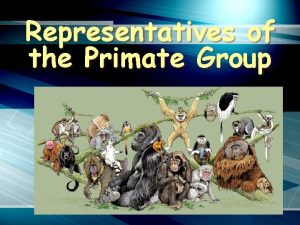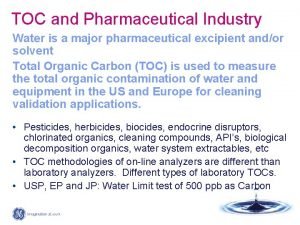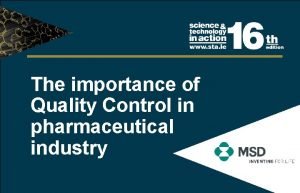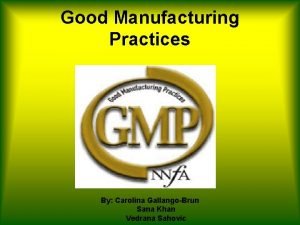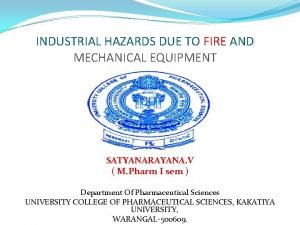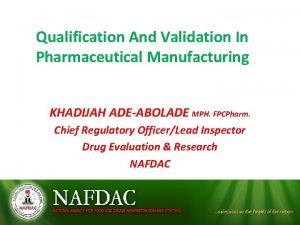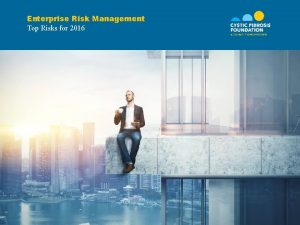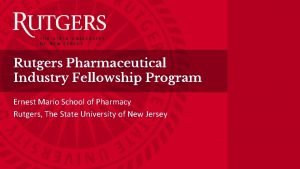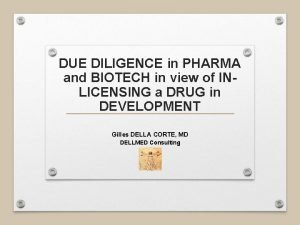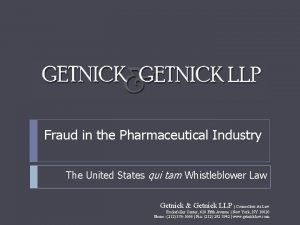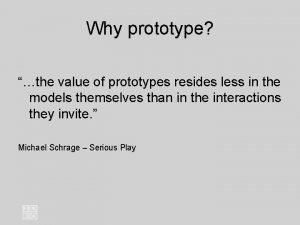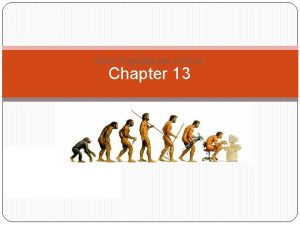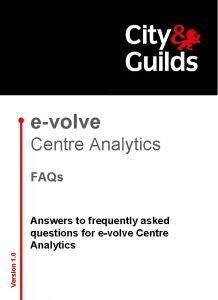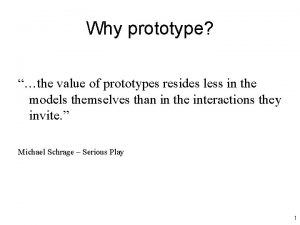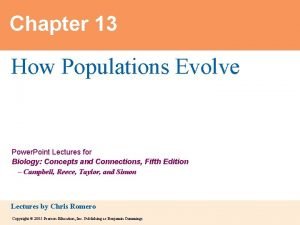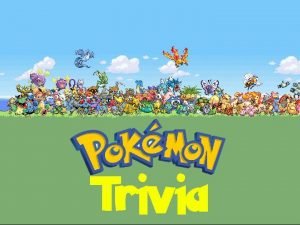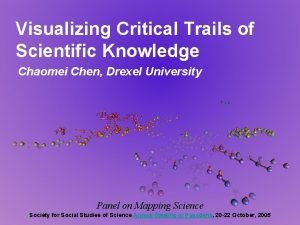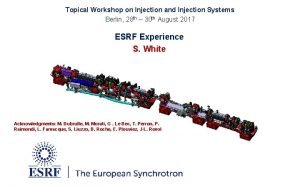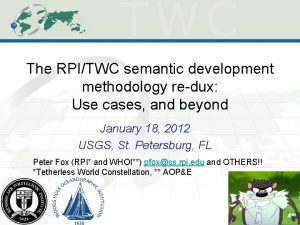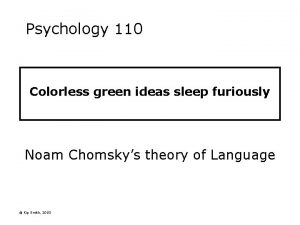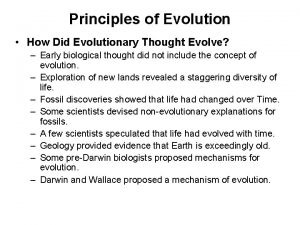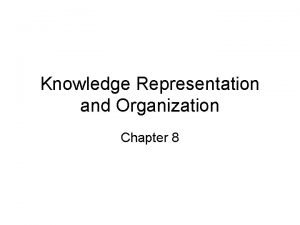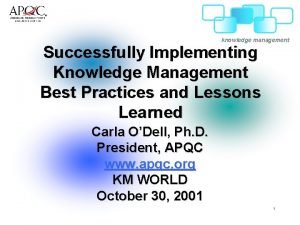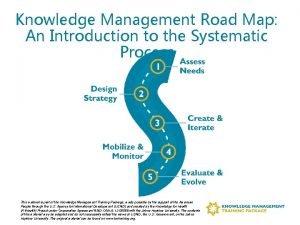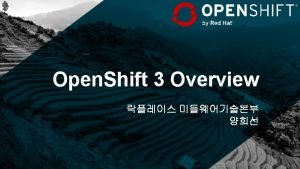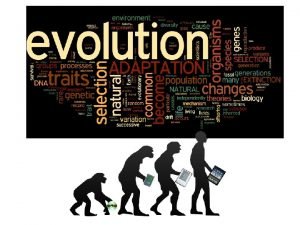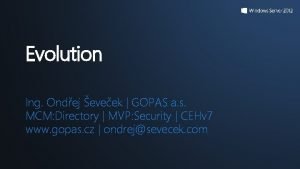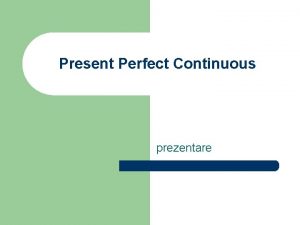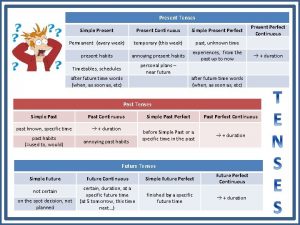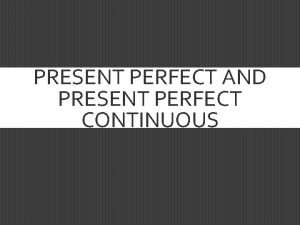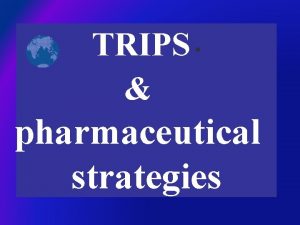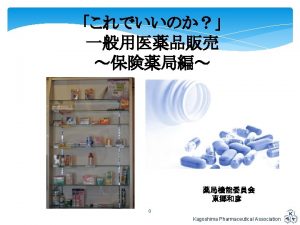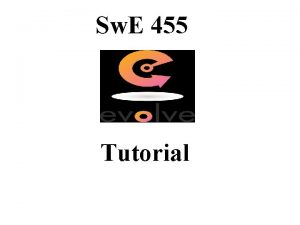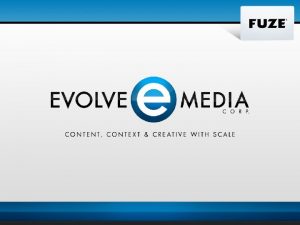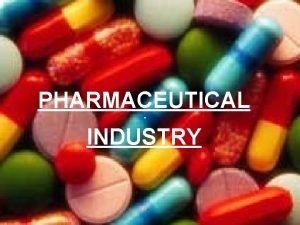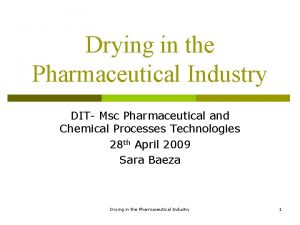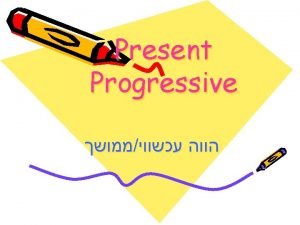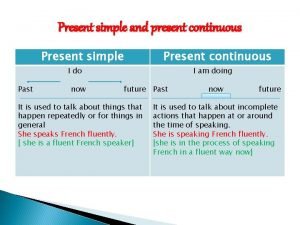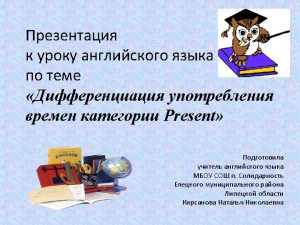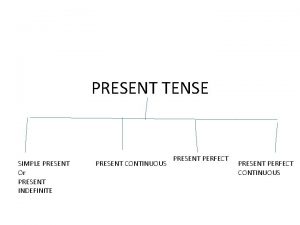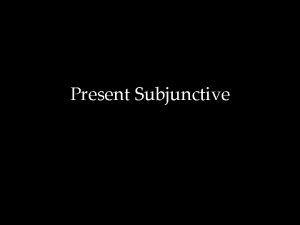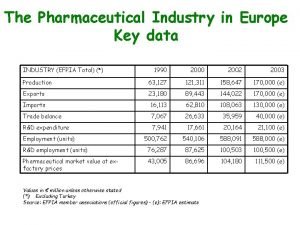How did the present pharmaceutical industry evolve How




























































- Slides: 60

• • How did the present pharmaceutical industry evolve? How does industry protect their discoveries? What’s in a name? How are drugs named? How does the pharmaceutical industry decide which diseases and/or biological mechanisms to target? • How many drug targets are there and how does one pick a good drug target?

History of the Pharmaceutical Industry • Most of today's major pharmaceutical companies were founded in the mid to late 19 th centuries. • They often evolved from pharmacies, who desired to produce their own medications in bulk. • Usually the products involved alkaloids, particularly including quinine

• John K. Smith founded a pharmaceutical company in 1841 • He brought in his bookeeper, Mahlon Kline a few years later • Finally, he merged his company with the perfume factory of Harry B. French to form Smith, Kline, and French.

• Parke, Davis & Co. originated in Detroit with the manufacture of chemical preparations in 1866.

• Key discoveries of the 1920 s and 1930 s, such as insulin and penicillin, became mass -manufactured and distributed (penicillin in WW II). Switzerlnd, Germany and Italy had particularly strong industries, with the UK and US following suit.

Old versus New Drug Labels • Legislation was enacted to test and approve drugs and to require appropriate labeling. • Prescription and nonprescription drugs became legally distinguished from one another as the pharmaceutical industry matured.

• Attempts were made to increase regulation and to limit financial links between pharmaceutical companies and prescribing physicians, including by the relatively new US FDA.


The Sulfanilamide Disaster • In 1937, S. E. Massengil Company created an elixir (liquid form) of the antibiotic sulfanilamide using diethylene glycol as solvent.

Ethylene Glycol Diethylene Glycol • Diethylene glycol is a great solvent, but extremely toxic. • Unfortunately, at the time, there were no legal requirement to test the toxicity of the formulation

• This resulted in the deaths of more than 100 people in the U. S.

• The United States Federal Food, Drug, and Cosmetic Act (abbreviated as FFDCA, or FD&C) was passed by Congress in 1938 • This law gives authority to the FDA to oversee the safety of food, drugs, and cosmetics.

• Numerous new drugs were developed during the 1950 s and mass-produced and marketed through the 1960 s. • This included the first oral contraceptive, The Pill, Cortisone, blood-pressure drugs and other heart medications. MAO Inhibitors, chlorpromazine (Thorazine), Haldol (Haloperidol) and the tranquilizers ushered in the age of psychiatric medication.

• The thalidomide tragedy of the 1960 s resulted in many pregnant women being prescribed a new tranquilizer that resulted in severe birth defects. • This resulted in increased calls for more regulation of the pharmaceutical industry.

• Other tranquilizers, such as Valium (diazepam), discovered in 1960, became best selling drugs, despite their propensity to cause addiction.

• In 1964, the World Medical Association issued its Declaration of Helsinki, which set standards for clinical research and demanded that subjects be given informed consent before enrolling in an experiment. Pharmaceutical companies became required to prove efficacy in clinical trials before marketing drugs.

• A number of new cancer drugs were produced in the 1970 s

• By the mid-1980 s, small biotechnology firms were struggling for survival, which led to the formation of mutually beneficial partnerships with large pharmaceutical companies and a host of corporate buyouts of the smaller firms. • Pharmaceutical manufacturing became concentrated, with a few large companies holding a dominant position throughout the world and with a few companies producing medicines within each country.

• New technologies, and new regulations, were beginning to transform the pharmaceutical industry in the 1980 s. These included the routine use of xray crystallography, the subsequent dawn of computer-assisted drug discovery, and the beginning of high throughput screening.

• The search for new drugs to combat the rapidly spreading (and fatal) retroviral disease HIV were a feature of pharmaceutical industry research in the 1980 s and 1990 s.

• The 1980 s also saw the beginning of an effort to hold down the cost of healthcare through Health Management Organizations (HMOs).

• A new business atmosphere became institutionalized in the 1990 s, characterized by mergers and takeovers, and by a dramatic increase in the use of contract research organizations for clinical development and even for basic R&D.


• In addition to the bad name that the pharmaceutical industry was beginning to acquire due to the high cost of healthcare and prescription medication tragedies, animal rights advocates began to confront the industry due to their use of animals in the initial evaluation of new products.

• Glaxo Wellcome + Smith. Kline Beecham = Glaxo. Smith. Kline Merger of Glaxo Wellcome and Smith. Kline Beecham creates pharmaceutical giant Alison Abbott, MUNICH, Munich JONNY EGGITT/FT Garnier: to head Glaxo Smith. Kline. The merger of the British pharmaceutical companies Glaxo Wellcome and Smith. Kline Beecham, which comes into effect this summer, creates a giant which could rank number one in the world in terms of spending on research and development (R&D). It will boast a portfolio of 30 new drugs and 19 vaccines in clinical trial. Glaxo Wellcome is currently the fifth-largest pharmaceutical company in the world in terms of turnover and Smith. Kline Beecham is ranked twelfth. The new company will have a stockmarket value of £ 110 billion (US$180 billion).

• Marketing changed dramatically in the 1990 s, partly because of a new consumerism. • The Internet made possible the direct purchase of medicines by drug consumers and of raw materials by drug producers, transforming the nature of business. • In the US, Direct-to-consumer advertising proliferated on radio and TV because of new FDA regulations in 1997 that liberalized requirements for the presentation of risks.

• The new antidepressants, the SSRIs, notably Fluoxetine (Prozac), rapidly became bestsellers.

• Drug development progressed from a hit-andmiss approach to rational drug discovery in both laboratory design and natural-product surveys. • Demand for nutritional supplements and socalled alternative medicines created new opportunities and increased competition in the industry.

• Controversies emerged around adverse effects, notably regarding Vioxx in the US, and marketing tactics. • Pharmaceutical companies became increasingly accused of disease mongering or over-medicalizing personal or social problems.

• There are now more than 200 major pharmaceutical companies, jointly said to be more profitable than almost any other industry, and employing more political lobbyists than any other industry. • Advances in biotechnology and the human genome project promise ever more sophisticated, and possibly more individualized, medications.

• The cost of bringing a new drug to market, beginning with the initial research, and continuing through clinical trials, has been estimated as high as $800 million, per drug.

Industry revenues • • • For the first time ever, in 2006, global spending on prescription drugs topped $600 billion, even as growth slowed somewhat in Europe and North America. Sales of prescription medicines worldwide rose 7 percent to $602 billion, according to IMS health, a pharmaceutical information and consulting company. The United States still accounts for most, with $252 billion in annual sales. Sales there grew 5. 7 percent.

Top Pharmaceutical Companies (sales)

How does the pharmaceutical industry protect its discoveries?

Patents • Under current law, a patent protects the new invention for a period of twenty years from the earliest date of filing. • To be patented, the invention must demonstrate novelty • One category under which most drug discoveries are filed is a new composition of matter.

Patent Protection by Country • U. S. patents are handled by the US Patent and Trademark Organization (USPTO). • The USPTO tries to make it easy for an individual inventor to file and maintain a patent. • LINK

European Patents • European Patents are handled through the European Patent Organization (EPO). • The costs of filing and maintaining a patent in the various European countries can be quite substantial.

• Once the patent term of a drug is expired, other companies can produce and market the drug. • This extra competition will reduce the price • However, these companies must use the generic name for the drug (not the brand name, see below)

Naming of drugs • A marketed drug has three names: a chemical name, a generic name, and a brand name. • A chemical name is given when a new chemical entity (NCE) is developed.

• The chemical name is a scientific name based on the compound's chemical structure (e. g. , 6 -thioguanine) and is almost never used to identify the drug in a clinical or marketing situation. • Often, the name is long and difficult to pronounce, and, since it has numbers, the number in the name might become confused with the numbers in the prescription.

• The generic name (or non-proprietary name) is granted by the USAN Council and is commonly used to identify a drug during its useful clinical lifetime. • Link

• The generic name does not belong to the company that discovers the drug (or owns the patent). Once the patent lifetime is expired, any company market the drug under the generic name.

• The generic name must be screened to assure that it does not resemble any other generic or brand name. • The generic name must also be appropriate for the class of drug.

• A listing of appropriate drug stem names can be found in the National Library of Medicine’s Drug Portal • The stems refer to the mechanism of action of the drug (not the disease condition) • Link


• The company that patents the drug creates the brand name (trademark). This name identifies the drug during the 17 years that the company has exclusive rights to make, sell, and use it under patent law.

Link

What does a drug look like? • If you are looking for drugs, you may be advised to know what they look like. • Christopher Lipinski, while working for Pfizer in the 1990 s, looked at thousands of drugs and drug candidates and came up with some generalizations.


Lipinski’s Rules of Five An orally active drug should have the following: • No More than five hydrogen bond donors • No more than ten hydrogen bond acceptors • A molecular weight under 500 Da • An octanol-water partition coefficient (log. P) less than 5 (where P = ratio of solubility in octanol / solubility in water)

How many useful biological targets are there that would recognize a drug?

How many drug targets are there?





What classes are important?

Assigned Reading • Gundersen L The complex process of naming drugs. Annals of internal medicine (1998), 129(8), 677 -8. • http: //www. medscape. com/viewarticle/469843 • (you will need to create a free medscape account, and to click on the box at lower right to see all 4 sections) • http: //www. fda. gov/About. FDA/What. We. Do/History/Pro duct. Regulation/Sulfanilamide. Disaster/default. htm • Hopkins Andrew L; Groom Colin R The druggable genome. Nature reviews. Drug discovery (2002), 1(9), 727 -30.

Assigned Reading (graduate students only) • Lipinski, C. A. ; Lombardo, F. ; Dominy, B. W. ; Feeney, P. J. Experimental and computational approaches to estimate solubility and permeability in drug discovery and development settings. Advanced Drug Delivery Reviews (2001) 46: 3 -26.

Homework • For each of the top ten pharmaceutical companies (slide 33), find their top selling drug, draw its structure, and explain what indication (disease) the drug is intended to treat. • What does USAN stand for? What does the USAN council do? • Approximately how many generic and trademark (brand) names are currently in use in the US? • What are Lipinski’s Rules? • Graduate students only: What specific changes occurring in the assay procedure prompted Chris Lipinski to come up with his rules. Explain. • Graduate students only: What chemical principles are underlying Lipinski’s Rules?
 Prosimii
Prosimii Toc in pharmaceutical industry
Toc in pharmaceutical industry Importance of quality in pharmaceutical industry
Importance of quality in pharmaceutical industry Good manufacturing practices in pharmaceutical industry
Good manufacturing practices in pharmaceutical industry Mechanical hazards in pharmaceutical industry
Mechanical hazards in pharmaceutical industry Customer satisfaction in pharmaceutical industry
Customer satisfaction in pharmaceutical industry Concurrent validation in pharmaceutical industry
Concurrent validation in pharmaceutical industry Enterprise risk management pharmaceutical industry
Enterprise risk management pharmaceutical industry Ernest mario
Ernest mario Pharmaceutical due diligence checklist
Pharmaceutical due diligence checklist Fraud in pharmaceutical industry
Fraud in pharmaceutical industry Explore evolve validate prototype
Explore evolve validate prototype Gene pool
Gene pool Chapter 13 how populations evolve test
Chapter 13 how populations evolve test Secure assess evolve
Secure assess evolve City and guilds secureassess
City and guilds secureassess Explore evolve validate prototype
Explore evolve validate prototype Richard millwood
Richard millwood Chapter 13 how populations evolve
Chapter 13 how populations evolve Hiv siv
Hiv siv Evolve
Evolve Pokemon słoń
Pokemon słoń Evolve knowledge
Evolve knowledge Evolve berlinist
Evolve berlinist Evolve knowledge
Evolve knowledge Colourless green ideas sleep furiously
Colourless green ideas sleep furiously History of evolutionary thought
History of evolutionary thought Organization of declarative knowledge
Organization of declarative knowledge Apqc
Apqc Evolve knowledge
Evolve knowledge Evolve
Evolve Homology vs analogy
Homology vs analogy Evolve windows xp
Evolve windows xp I write a letter now past continuous tense
I write a letter now past continuous tense Present perfect conjugation
Present perfect conjugation Present perfect continuous schema
Present perfect continuous schema Simple present present perfect present progressive noredink
Simple present present perfect present progressive noredink Send present perfect
Send present perfect Present simple present continuous present perfect
Present simple present continuous present perfect Present simple present continuous and present perfect
Present simple present continuous and present perfect Hát kết hợp bộ gõ cơ thể
Hát kết hợp bộ gõ cơ thể Lp html
Lp html Bổ thể
Bổ thể Tỉ lệ cơ thể trẻ em
Tỉ lệ cơ thể trẻ em Gấu đi như thế nào
Gấu đi như thế nào Tư thế worm breton
Tư thế worm breton Alleluia hat len nguoi oi
Alleluia hat len nguoi oi Các môn thể thao bắt đầu bằng tiếng đua
Các môn thể thao bắt đầu bằng tiếng đua Thế nào là hệ số cao nhất
Thế nào là hệ số cao nhất Các châu lục và đại dương trên thế giới
Các châu lục và đại dương trên thế giới Công của trọng lực
Công của trọng lực Trời xanh đây là của chúng ta thể thơ
Trời xanh đây là của chúng ta thể thơ Mật thư tọa độ 5x5
Mật thư tọa độ 5x5 101012 bằng
101012 bằng độ dài liên kết
độ dài liên kết Các châu lục và đại dương trên thế giới
Các châu lục và đại dương trên thế giới Thơ thất ngôn tứ tuyệt đường luật
Thơ thất ngôn tứ tuyệt đường luật Quá trình desamine hóa có thể tạo ra
Quá trình desamine hóa có thể tạo ra Một số thể thơ truyền thống
Một số thể thơ truyền thống Cái miệng xinh xinh thế chỉ nói điều hay thôi
Cái miệng xinh xinh thế chỉ nói điều hay thôi Vẽ hình chiếu vuông góc của vật thể sau
Vẽ hình chiếu vuông góc của vật thể sau
